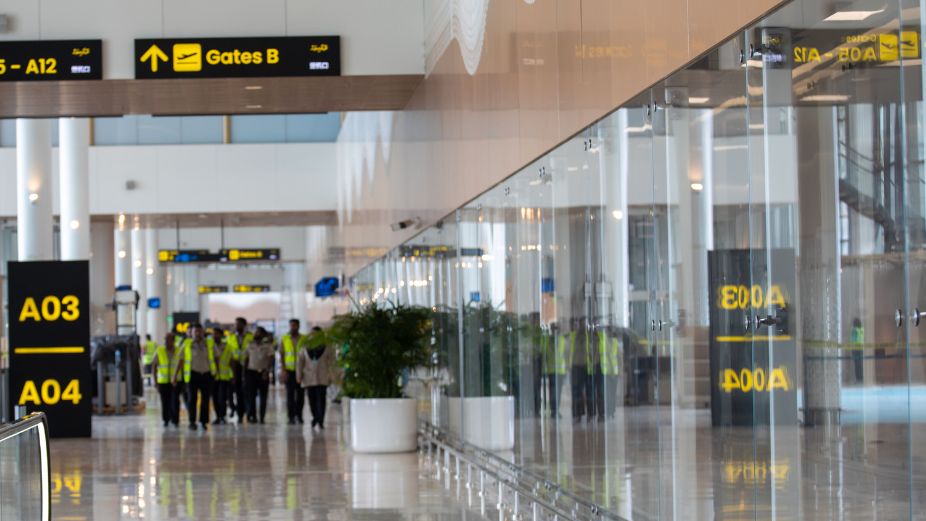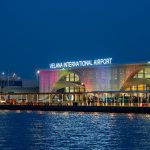
On 26 July 2025, the Maldives will mark its 60th Independence Day with more than just pageantry. At the edge of Hulhulé Island, beside an airstrip once hand-paved by volunteers in 1966, a new terminal will open its doors, not just to tourists, but to a new chapter in the country’s economic story.
It is a story that, like the terminal itself, is bold in ambition and intricate in meaning.
The structure is vast: 72,000 square metres of wave-inspired curves, terrazzo floors that shimmer like sunlit lagoons, and ceilings that mimic the undulating sky. The architectural details are unmistakably Maldivian, but the scale is international. With capacity for 7.5 million passengers a year, 12 jet bridges, 47 check-in counters, 28 arrival immigration desks, and a state-of-the-art baggage system, this is not just an airport. It is an assertion. A claim that the Maldives can meet the world on its own terms.
But airports are never just about movement. They are about memory, message, and meaning. They tell you what a country thinks of itself and what it wants you to think of it.
This new terminal wants you to know that the Maldives is ready.
From Volunteer Asphalt to Global Hub
In 1966, locals from Malé poured buckets of sweat and gravel into a new runway, competing by district to see who could contribute more. That effort gave birth to Hulhulé Airport. It wasn’t pretty, but it worked. It got the job done when the job was simply to land a plane safely.
Sixty years later, the job is different. Tourism accounts for more than a quarter of GDP. Over 2 million visitors passed through the old terminal last year, straining infrastructure meant for half that. The new terminal is not a luxury. It is a necessity. If the Maldives is to thrive in a competitive global tourism market, it needs to offer not just clear waters and luxury resorts, but smooth, modern arrivals.
The Cost of Becoming World-Class
That necessity came at a price. Nearly USD 1 billion has been spent on the greater expansion of Velana International Airport, including a new runway, cargo facilities, fuel farm, the Noovilu Seaplane Terminal, and now this new international terminal. While not the sole recipient of those funds, the terminal is the centrepiece. The scale is immense, and the implications for national development are far-reaching.
Critics have questioned the opacity of some contracts and the long delay from the original 2018 completion date. But for officials, the cost is justified. MACL promises world-class service. The Maldives Marketing and PR Corporation calls the terminal “crucial” to tourism goals. President Muizzu, eager to tie his administration to this milestone, pushed for the opening to be brought forward to Independence Day. Symbolism matters.
Arrival as Narrative
When passengers step into the terminal, they’ll enter a story told in steel and stone. The wave-shaped ceilings, mosque-inspired carvings, and beach-toned palettes don’t just decorate the space. They frame the country. They say, “You’ve arrived somewhere different. Somewhere that knows who it is.”
Compare this with Changi’s butterfly garden or Doha’s cavernous luxury. Each terminal is a flag in glass. Velana’s new terminal plants one for the Maldives. Not just as a destination, but as a player in the architecture of global movement.
And in doing so, it hopes to reshape the way the world engages with it.
The Real Test
Still, infrastructure is only as successful as its operations. Transitioning flights, avoiding baggage hiccups, training staff, these are the less glamorous challenges that will define whether the terminal works. If the queues of the past become the frustrations of the future, the gloss of the launch will fade fast.
Beyond that, the deeper question lingers. Is this just about facilitating movement, or about controlling narrative? Is the Maldives building for its people, or primarily for its visitors?
The government says both. Maldivians will board through jet bridges now. Local jobs will expand. National pride will be restored. But as with all grand public works, the answer will come slowly, in the form of maintenance budgets, usage data, and public sentiment.
A Gateway Reimagined
So what does the new terminal say about the Maldives?
It says the country wants to be seen. It says it remembers its past but is betting on a larger future. It says that for all the debates about debt and delay, it still believes that a small island nation can build something big, beautiful, and globally significant.
When the first aircraft taxis to the gate on 26 July, it will not just mark the arrival of a flight. It will mark the arrival of a different kind of Maldives. One more connected. One more confident. And one still trying, after all these years, to shape the story the world sees when it lands here.








